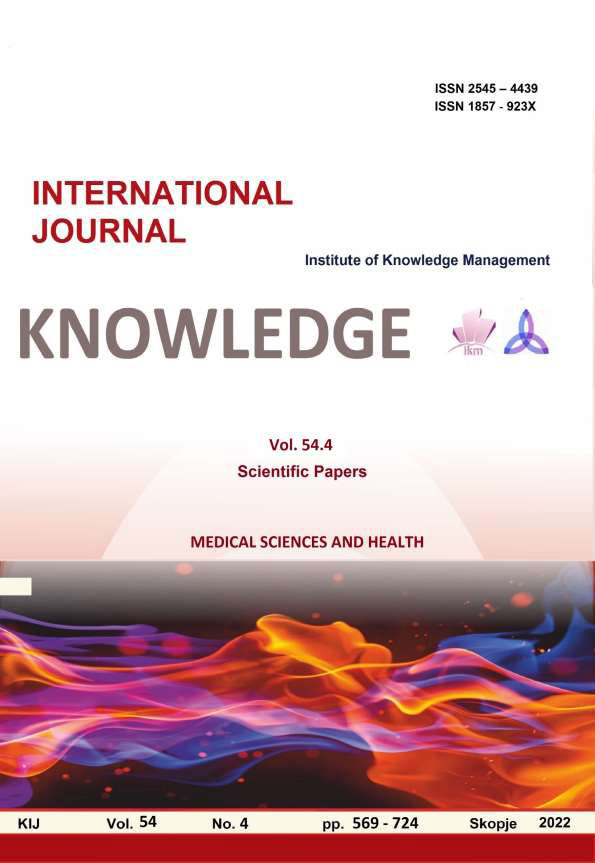CRITICAL EQUIPMENT QUALIFICATION PARAMETERS AFFECTING THE HOMOGENIZATION PROCESS OF MEDICAL CANNABIS SEMI-SOLID PHARMACEUTICALS
DOI:
https://doi.org/10.35120/kij5404669cKeywords:
medical cannabis, semisolids, qualification, critical process parametersAbstract
The medical cannabis has been used for many of years for medicinal purpose, in different pharmaceutical
formulation, mostly as a magistral preparation for the relief of pain in cancer patients or chronical painful diseases.
Over than 540 substances were found from which more than 100 that have been found to be cannabinoids due to
their similar chemical structure. The component with the most psychotropic action is Δ9 -tetrahydrocannabinol (Δ9 -
THC), and the major non-psychoactive ingredient is cannabidiol (CBD). Δ9 -tetrahydrocannabinol firstly was
isolated in 1969 by Robert Mechoulm and Yechiel Gaoni. In 2003 World Health Organization put Δ9 -
tetrahydrocannabinol in Schedule IV of the convention. Several therapeutic indications relate to the Δ9 -THC and
CBD as analgesia, inflammatory and neurodegenerative diseases, and many other cases. In some studies, there are
reported safety concerns about the registered side effects of Δ9 - THC as a psychoactive. For that reason, the legal
usage of cannabis for medicinal purposes and for recreational use is regulated differently. The most relevant
explanation is related to the not enough sufficient results and data obtained from the pharmacokinetic studies and
research in pharmacological behavior. Extracts of cannabis was used from many years ago. Nowadays in
pharmaceutical industry as the development of technology there are many dosage forms in where extracts,
cannabinoids, flower are used. Medicinal cannabis products can come in many different forms, including capsules,
drops, chewable, creams, crystals, flower, lozenges, oil (most common), oro-mucosal sprays, tinctures and many
more. Also, there are synthetic analogs to nature cannabinoids in pharmaceutical market. In this study will be
discussed about production of semisolid pharmaceutical forms obtained from medical cannabis. They are produced
in pharmaceutical grade equipment, high-pressure homogenizer mixer. In this study it will be discussed about the
process of equipment qualification. Firstly, by the user requirement specification, design qualification protocol was
approved. Then factory acceptance test was performed in production site of equipment and site acceptance test was
performed in costumer’s site. Then installation qualification protocol was look through and then operational
qualification protocol also. All the qualification protocols were approved by both sides. In different qualification
protocols, different tests were performed, and they are explained separately. During the qualification process, there
are considered some of the parameters which later during the production process can affect in the quality of finished
products. These parameters are called critical process parameters and accent will be put on this process parameters
that are with a critical effect on quality of the final products. This critical process parameters were considered and
concluded from qualification protocols where all the parameters that can affect quality of the product were
separately examine.
References
Elsohly & Slade (2005). Chemical constituents of marijuana: the complex mixture of natural cannabinoids. Life Science. 22;78(5):539-48
Markus, V. (2022). Quality Requirements for Medicinal Cannabis and Respective Products in the European Union – Status Quo. Planta Medical Journal
Maqbool, A., Mishra, M.K., Pathak, S., Kesharwani, A., & Shambhunath, A.K. (2017). Semi solid dosage forms manufacturing: tools, critical process parameters, strategies, optimization and recent advance. Indo American Journal of Pharmaceutical Research. ISSN NO:2231-6876
Moreno, T., Dyer, P., & Tallon, S. (2020). Cannabinoid decarboxylation: A comparative kinetic study. Journal of American chemical society
Nwoko, & Valentine, E. (2014). Semi Solid Dosage Forms Manufacturing: Tools, Critical Process Parameters, Strategies, Optimization and Validation. Scholars Academic Journal of Pharmacy. 3: 153–161
Patel, Kalpen, & Holley A. (2018, January 30). Quality Factors Influencing Semi-Solid Manufacturing. Retrieved from
Reddy, B.V., Reddy, B.R., Navaneetha, K., & Reddy, K.V. (2014). A review on qualification of autoclave, RMG, FBD, cone blender, tablet compression machine. Journal of global trends in pharmaceutical sciences. ISNN: 2230-7346
Romano & Hazekamp (2019). An overview of galenic preparation methods for medicinal cannabis. Journal of Current Bioactive Compounds.1;15(2):174-95
Ruhul & Declan (2019). Pharmacology of Medical Cannabis. Journal of Springer Nature. p.151-165
Russo, E.B. (2011). Taming THC: potential cannabis synergy and phytocannabinoid-terpenoid entourage effects. Br Journal of Pharmacology;163(7):1344-64
Stella, B., Baratta, F., Della, P.C., Arpicco, S., Gastaldi, D., & Dosio, F. (2021). Cannabinoid Formulations and Delivery Systems: Current and Future Options to Treat Pain. Drugs. 81(13):1513-1557
Sheriff, T., Lin, M.J., Dubin, D., & Khorasani, H. (2020). The potential role of cannabinoids in dermatology. Journal of Dermatological Treatement. 31(8):839–845





